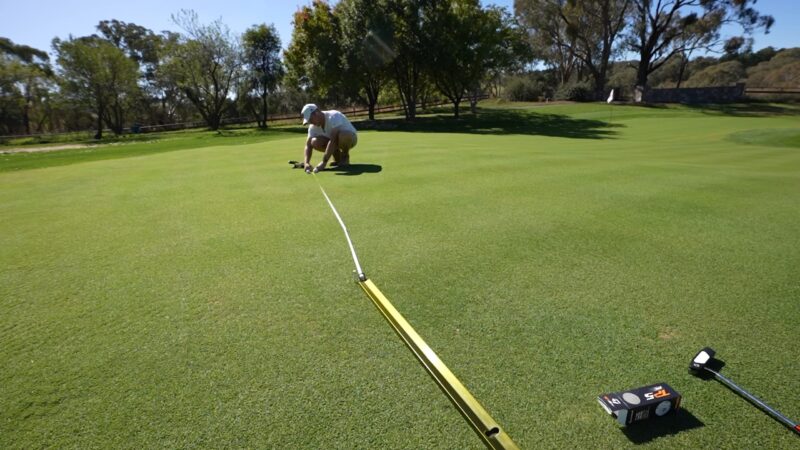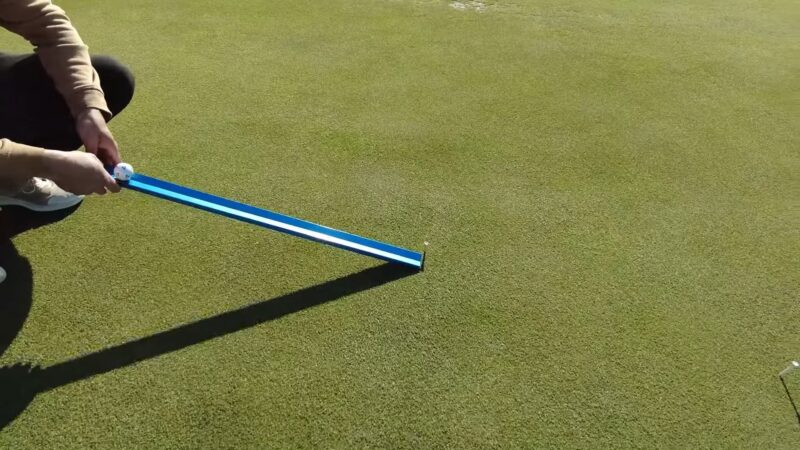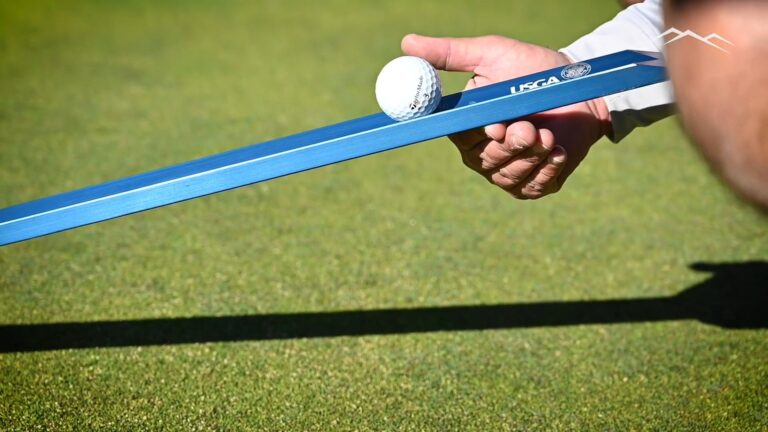The game of golf is a sport where the smallest of details can make the biggest difference. One such detail is the consistency of green speed. Trying to putt on a surface where the speed changes unpredictably is frustrating to say the least!
That’s where our trusty friend, the stimpmeter, comes into play. An essential tool that helps us achieve that much-needed consistency on the greens.
The Role of the Stimpmeter
Uniform green speed ensures that players, whether beginners or pros, have a level playing field. Now, variations in green speed? They can be a real game-changer, and not in a good way.
A faster or slower green can drastically alter a player’s strategy and shot execution. The stimpmeter, in its humble way, helps us maintain that uniformity, ensuring that the only variables players need to worry about are their skills and strategies.
Fun Fact: The stimpmeter was named after its inventor, Edward S. Stimpson, a 1930s golfer who wanted a better way to measure green speeds!
Evolution of Green Speed Measurement

Back in the day, measuring green speed was a bit of a guessing game. Golfers relied on intuition, experience, and sometimes just plain luck.
But as the sport evolved, so did the need for precision. Enter the stimpmeter!
This tool was nothing short of revolutionary. It provided a standardized way to measure green speed, bringing science and consistency to a previously unpredictable aspect of the game.
Mechanics

At first glance, it might seem like a simple piece of equipment. But, as they say, beauty lies in simplicity. The stimpmeter consists of three main components:
- Base: This is the foundation, ensuring stability during measurements.
- Ramp: A sloped section where the golf ball is released.
- Indicator: This part shows where the ball comes to a stop, helping in the measurement process.
Using it is a breeze. Its design is straightforward, making it user-friendly even for those new to the world of golf course management.
| Benefit | Description |
| Course Setup | Enables optimal setup, especially for tournaments |
| Player Strategy | Helps players plan their shots better |
| Maintenance | Assists greenkeepers in understanding and adjusting green conditions |
Measuring Process
Alright, let’s get down to the nitty-gritty of how to measure green speed using a stimpmeter. It’s a process that, while simple, requires attention to detail:
- Positioning: Place it on a flat section of the green. Remember, accuracy is key!
- Ball Release: Gently release a golf ball from the top of the ramp.
- Observation: Watch as the ball rolls down and comes to a stop on the green.
- Measurement: Use the indicator to measure the distance the ball has traveled in feet.
Pro Tip: It’s crucial to repeat the process a few times to get an average reading. This ensures that the measurement is as accurate as possible!
| Step | Description |
| 1 | Position on a flat section |
| 2 | Release the golf ball from the ramp |
| 3 | Observe the ball’s movement |
| 4 | Measure the distance traveled |
Factors Affecting Green Speed

Green speed isn’t just about the surface; several factors come into play:
- Grass Type: Different grasses have different textures and growth patterns, affecting speed.
- Moisture: A wet green can slow down the ball, while a dry one can make it zip across.
- Slope: The incline or decline of the green can naturally influence the ball’s speed.
The beauty of the tool is that it helps greenkeepers and course managers understand these factors better. By taking readings at different times and conditions, they can make informed decisions about maintaining the green.
Fun Fact: Bentgrass and Bermuda grass are among the most common types of grasses used on golf courses, each offering a unique playing experience!
Interpreting Measurements
So, you’ve got your reading from the stimpmeter. Now what? The distance the ball travels on the ramp is directly related to the green speed. A simple formula to keep in mind is:
Green Speed (in feet) = Distance ball traveled (in feet)
For instance, if the ball traveled 10 feet, the green speed is 10. It’s that straightforward!
Pro Tip: While the formula is simple, it’s essential to consider other factors like wind and humidity, which can influence the ball’s travel distance.
Course Management
The stimpmeter isn’t just a tool; it’s a guide for course managers. By understanding green speeds, they can set up courses optimally, especially for tournaments. Faster greens might be preferred for professional tournaments, adding an extra layer of challenge.
Professionals often use stimpmeter data to strategize their game. Knowing the green speed helps them decide on the force to apply and the path to take, making those crucial putts a tad bit more predictable.
| Benefit | Description |
| Course Setup | Enables optimal setup, especially for tournaments |
| Player Strategy | Helps players plan their shots better |
| Maintenance | Assists greenkeepers in understanding and adjusting green conditions |
Limitations

As fantastic as the stimpmeter is, it’s essential to acknowledge that no tool is without its limitations. While the tool provides a standardized way to measure green speed, it doesn’t capture the full picture:
- Environmental Factors: While it can measure the speed at a given moment, it doesn’t account for changing environmental conditions like sudden rain or a spike in humidity.
- Human Error: The process, though simple, is still manual. Inconsistencies in ball release or positioning can lead to varied readings.
- Localized Measurements: Measures a specific spot on the green. This might not represent the entire green’s speed, especially if there are variations in grass health or soil conditions.
Fun Fact: It was initially made of wood, but modern versions are typically made of metal or plastic for durability!
Advancements in Green Speed Technology

While the stimpmeter remains a staple in green speed measurement, technology never stands still. There have been significant advancements complementing the traditional tool:
- Digital Stimpmeters: These devices offer digital readings, reducing the chances of human error and providing more consistent results.
- Moisture Sensors: Integrated into some modern tools, these sensors can give insights into the green’s moisture levels, adding another layer of data for greenkeepers.
- Green Mapping Technology: Advanced software solutions now allow for detailed mapping of greens, highlighting variations in speed across the entire surface.
FAQ
Can the stimpmeter be used on any type of grass?
Yes, it is versatile and can be used on various types of grass, including Bentgrass, Bermuda, and others.
How often should green speed be measured?
The frequency of measurements depends on the level of play and the specific needs of a course. For professional tournaments, it’s often measured daily or even multiple times a day.
Is the stimpmeter used only in professional golf?
No, it is used in both professional and amateur settings. Many local golf clubs use it to maintain consistent green speeds.
Can wind affect the stimpmeter readings?
Yes, wind can influence the distance the ball travels, thereby affecting the reading. It’s best to take measurements when wind conditions are calm.
Can a stimpmeter be used indoors?
Yes, it can be used indoors on artificial greens, but keep in mind that artificial surfaces may not perfectly mimic natural grass conditions.
Can I build a DIY stimpmeter?
While it’s possible to build a DIY version, it may not provide the same level of accuracy as a professionally manufactured one.
Conclusion
I hope the journey through the world of the stimpmeter has been enlightening for you. From its humble beginnings to its pivotal role in modern golf, the tool has proven its worth time and again. It’s not just about numbers on a scale; it’s about ensuring that the game remains fair, challenging, and enjoyable for everyone.
But as with all things, it’s essential to remember that while the stimpmeter is a fantastic tool, it’s just one piece of the puzzle. The advancements in green speed technology, combined with the expertise of greenkeepers and course managers, ensure that the golfing experience is continually evolving and improving.

